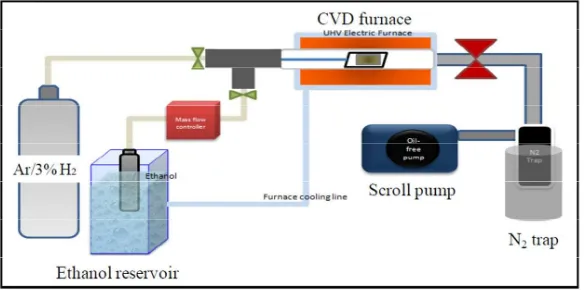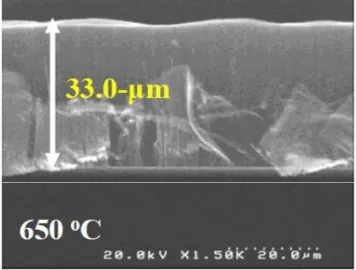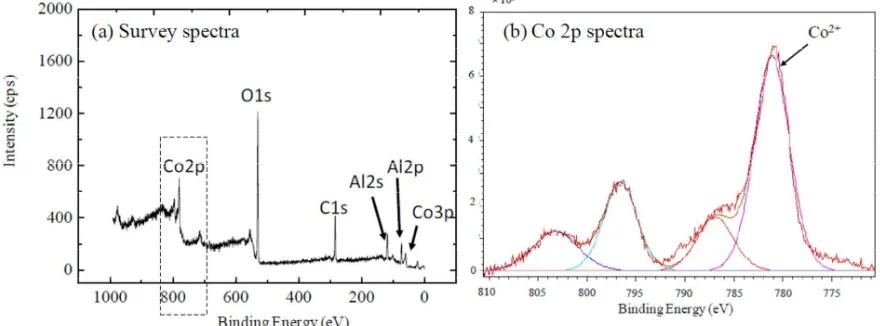Procedia Engineering 68 ( 2013 ) 566 – 571
1877-7058 © 2013 The Authors. Published by Elsevier Ltd.
Selection and peer-review under responsibility of The Malaysian Tribology Society (MYTRIBOS), Department of Mechanical Engineering, Universiti Malaya, 50603 Kuala Lumpur, Malaysia
doi: 10.1016/j.proeng.2013.12.222
ScienceDirect
The Malaysian International Tribology Conference 2013, MITC2013
Nanostructuring Ultra-thin Co Films to Active Catalyst Particles for
Vertically Aligned Single-Walled CNT Growth
M. A. Azam
a, b,*, R. Izamshah
a, N. Mohamad
a, K. Isomura
b, T. Shimoda
baFaculty of Manufacturing Engineering, Universiti Teknikal Malaysia Melaka, Hang Tuah Jaya, 76100 Durian Tunggal, Melaka, Malaysia bSchool of Materials Science, Japan Advanced Institute of Science and Technology (JAIST), 1-1 Asahidai, Nomi, 923-1292 Ishikawa, Japan
Abstract
In the field of material synthesis using chemically-derived technique, nanostructuring metal catalyst particles towards high quality production of carbon nanotubes (CNTs) has been very attractive. In this work, cobalt (Co) which used as catalyst for vertical growth of CNTs were studied by means of transmission electron microscopy (TEM), scanning electron microscopy (SEM), and X-ray photoelectron spectroscopy (XPS). Aluminum (Al) films (20 nm) were thermally-oxidized to form aluminum oxide (Al-O) to support 0.5 nm Co catalyst during CNT growth. In growing CNTs by using chemical vapor deposition (CVD) technique, the role and characters of all involving materials are crucial to the growth result. From the Co/Al-O substrate and at 650 oC of CVD temperature, 33-Pm thick of vertically aligned single-walled CNT (VA-SWCNT) forest has been grown. TEM particle analysis revealed that the Co particles have an average of 3.50 nm experimentally and in principle favored the growth of highly demanded VA-SWCNTs. The as-prepared Co particles are suggested chemically active for the CNT growth. In addition, XPS analysis confirmed the surface chemical state of Co particles prior to the VA-SWCNT growth using ethanol based CVD system.
© 2013 The Authors. Published by Elsevier Ltd.
Selection and peer-review under responsibility of The Malaysian Tribology Society (MYTRIBOS), Department of Mechanical Engineering, Universiti Malaya, 50603 Kuala Lumpur, Malaysia.
Keywords: Cobalt catalyst particle; single-walled CNT; alcohol catalytic CVD; TEM analysis; XPS
1.Introduction
Single-walled carbon nanotube (SWCNT) is a promising next-generation material because of their novel electronic, mechanical and chemical properties. In particular, vertically aligned SWCNTs (VA-SWCNTs) has been expected to be greatly applicable to energy storage devices because of its large surface area [1, 2]. An electrochemical capacitor using a symmetric VA-SWCNT electrode was successfully fabricated, and importantly the performance was a world-top class level, with a 584 F g-1 specific capacitance value [3]. In energy storage application, the distance between CNTs and the spatial distribution of CNTs are important because the capacitor performance is believed to be improved by increasing the total number of electrolyte ions (electrical charge) adsorbed onto CNT surfaces.
For SWCNT growth using ethanol based chemical vapor deposition (CVD) system, Co catalyst plays a major role towards the production of high density and high quality nanotubes. Regardless of the growth method, CNT
* Corresponding author. Tel.: +6-06-331 6972; fax: +6-06-331 6431.
E-mail address: [email protected]
© 2013 The Authors. Published by Elsevier Ltd.
formation strongly depends on catalytic activity and catalyst lifetime [4, 5]. Specifically, it is assumed that the morphology of the Co catalyst particles might strongly affects the spacing between the CNTs as well as the CNT diameter distribution and thus the device performances. However, study on the Co catalyst particles themselves has not progressed far enough. For example, the crystal structure and the oxidation state of the Co catalyst particles have not been clearly figured out yet. Regardless of the desired CNT structures (alignment, dimension etc.), the fundamental understanding of Co catalyst particle in actively nucleating CNT is very crucial and can still be considered as the missing piece of the puzzle inside SWCNT growth. In this work, the morphology and surface chemical state of the Co particles were studied as to explore any possibilities of its direct relation to desired CNT structure for multi-scale applications.
2.Materials and Method
First, a heavily doped n-typesilicon wafer (10 x 10 x 0.5 mm3) with a 400-nm-thick thermally oxidized SiO2
layer on its surface was used as the substrate. The substrates were rinsed with acetone, then sonicated in ethanol for 10 min cleaning using ultrasonic bath, and finally exposed to UV-O3 for 10 min for the cleaning process. The Al
thin films of 20 nm nominal thickness were deposited using electron beam physical vapor deposition (EBPVD) at 10-4 Pa. The deposition rate was monitored by a quartz resonator and was kept constant at 0.1 nm sec-1. For the formation of Al-O catalyst-support layer for vertical CNT growth, deposited Al was first naturally-oxidized at room temperature for 2 hours. Then, the substrate was subsequently transferred to CVD reactor used for CNT growth, and thermally oxidized at 400 oC in static air for 10 min.
For CNT growth, Co catalyst (0.5 nm nominal thickness) was consequently deposited on top of Al films using the same EBPVD, and then followed by the oxidation process of Al films. It is important to note that Co deposition on Al films before or after oxidation process of Al-O support layer produced qualitatively the same results, within experimental error of CNT growth results. As illustrated in Fig. 1, electric furnace (MILA-3000) was employed as the CVD reactor, and ethanol (EL grade, 99.9%; Kanto Chemical) was used as the carbon source (feedstock) [5 – 7]. Ar/H2 (3% H2) as the pretreatment gas was supplied into the reactor at a pressure of 0.4 KPa concurrently with 4
min rapid ramping of the furnace. The Ar/H2 gas continuously flowed after the furnace temperature reached the
CVD temperature (TCVD) of 600 – 800 oC for further 5 min annealing process. Then, the mixed gas flow was stopped,
and then ethanol vapor was immediately introduced into the furnace at flow rates of 110 – 130 sccm. The annealing and CNT growth were carried out at the same temperature (50 oC interval). The internal pressure and CVD processing time were fixed at 3 KPa and 10 min, respectively.
Fig. 1. Schematic illustration of ACCVD system used for VA-SWCNT growth in the laboratory.
3.Results and Discussion
First, the VA-SWCNT growth result will be discussed (Table 1). Upon extensive analysis of VA-SWCNT growth, it was found that the CNTs grown at 650 oC (annealing and CVD temperatures) resulted in the highest thickness (CNT vertical length) of 33-Pm. From the very thin Co catalyst film, SWCNTs grown from the Co particles are expected to be very thin in the diameter. Thus, at higher temperature, CNT growth dynamic might be thermally affected by the burning of the CNTs during the CVD process [8]. The high-resolution SEM image in Fig. 2 shows the vertical alignment of CNT forest perpendicular to the substrate, where most of the area of the substrate was covered by VA-CNTs. On the other hand, in the previous studies, the peaks at the radial breathing mode (RBM) region in the Raman spectrum verified the presence of single-walled (SW-) CNTs [8 – 10]. Thus, it is crucial to investigate the physical condition of Co particles that annealed and grown at this temperature. For such temperature dependence analysis, appropriate CVD temperature will directly affect not only the Co particle size and shape, but importantly the Co catalytic activity; the more active particles being prepared, the CNT amount (and/or density) grown on the substrate will be higher.
Table 1. VA-SWCNT growth results based on VA-SWCNT height depending on different CVD temperatures.
CVD temperature, TCVD
(oC)
SWCNT forest thickness, tCNT
(Pm)
600 8
650 33
700 16
750 14
Fig. 2. Cross-sectional HR-SEM image of VA-SWCNT forest grown from Co/Al-O at 650 oC, 5 min.
For the existence and spatial distribution analysis of Co particles, high resolution TEM analysis was carried out. Fig. 3 depicts the plane view image of Co particles on Al-O after being annealed at CVD temperature, 650 oC. White dots in the image were Co particles, and the background was the Al-O. This result confirmed that Co ultra thin films changed to nano-sized particles as soon after annealing process. Also, it was found that the Co particles have an average diameter of approximately 3.50 nm. The 3.50 nm mean diameter of the Co particle is acceptable for a root growth mode mechanism, and in principle, CNT diameter does not exactly follow the diameter of catalyst particle, it must be slightly smaller than the catalyst particle [6]. In addition, from the clear observation of the distance between Co catalyst particles, it can be suggested that the individual or bundle of vertical CNTs grown with a space between each other. This will be one good advantage for the use in energy storage device, in which the electrolyte ion has better accessibility to the CNT surfaces [3, 11, 12].
Fig. 3. TEM plane view image of Co particles on Al-O and its particle diameter analysis. Small white dots are the Co, and the background is the Al-O.
Another significant finding was elaborated from the XPS analysis in order to investigate surface electronic/chemical states of the Co particles. Fig. 4(a) depicts the typical survey spectrum of Co/Al-O after being annealed at 650 oC, in vacuum. From this spectrum, substrate`s surface contributed 6 main photoelectron signals; Al 2p, Al 2s, C 1s, O 1s, and 2 Co main peaks. Co 2p and Co 3p peaks were clearly observed at around 800 and 65 eV [5]. Importantly, no photoelectron intensity was reflected from the SiO2 underlayer; the absence of Si signals
In Fig. 4(b), the Co 2p narrow spectrum was normalized at the maximum intensity in order to facilitate clear comparison. The intensities of all signals in this region indicate a direct measure of the degree of Co dispersion. Here, it was found that the catalyst particles were composed a mixture of Co metal and/or Co oxide. Although a detailed structural analysis using other supporting techniques like TEM-EDS and TEM-ELLS are crucial, here it can be suggested that the as-annealed Co catalyst particles owing a crystal structure that would be active for the CNT growth. In future, with the aid of the material theoretical/simulation analysis, it can be a huge opportunity to open the possibility of controlling spatial distribution of CNT by changing catalytic behavior of the Co particles.
Fig. 4. XPS analysis of Co on Al-O after being annealed at 650 oC, 5 min.
4.Conclusion
For clarification of the Co catalyst activity during the SWCNT growth using ACCVD, morphology and surface chemical state of the Co particles were investigated. In particular, Co particles size, distribution and oxidation state of Co particles have been analyzed. From TEM, it was found that the Co particles were well distributed and the mean diameter for Co on Al-O support layer was calculated to be 3.50 nm. The oxidation state Co catalyst particles were investigated using XPS. From the result, Co particles were in the mixture states of Co metal and Co oxide. This work will contribute to the progress towards a clear mechanism clarification of the catalyst activity of Co catalyst particles in the SWCNT growth.
Acknowledgements
Major part of this work was supported by Grant-in-Aid for Japan Society of Promotion Science (JSPS) Research Fellows, and Ministry of Science, Technology and Innovation (MOSTI), Malaysia for financial support under eScienceFund research grant scheme. The authors are also thankful to Mr. N. Ito (Center for Nano Materials and Technology, JAIST) for HR-SEM observation support.
References
[1] Azam, M. A., Fujiwara, A., Shimoda, T., 2011. Direct growth of vertically-aligned single-walled carbon nanotubes on conducting
substrates using ethanol for electrochemical capacitor, J. New Mat. Electrochem. Systems 14, p. 173-178.
[2] Talapatra, S., Kar, S., Pal, S. K., Vajtai, R., Ci, L., Victor, P., Shaijumon, M. M., Kaur, S., Nalamasu, O., Ajayan, P. M., 2006. Direct
[3] Azam, M. A., Isomura, K., Fujiwara, A., Shimoda, T., 2012. Direct growth of vertically aligned single-walled carbon nanotubes on conducting substrate and its electrochemical performance in ionic liquids, Phys. Status Solidi A 209, p. 2260 – 2266.
[4] Amama, P. B., Pint, C. L., Kim, S. M., McJilton, L., Eyink, K. G., Stach, E. A., Hauge, R. H., Maruyama, B., 2010. Influence of Alumina
Type on the Evolution and Activity of Alumina-Supported Fe Catalysts in Single-Walled Carbon Nanotube Carpet Growth, ACS Nano 4, p. 895.
[5] Azam, M. A., Fujiwara, A., Shimoda, T., 2011. Thermally oxidized aluminum as catalyst-support layer for vertically aligned single-walled
carbon nanotube growth using ethanol, Appl. Surf. Sci. 258, p. 873 – 882.
[6] Azam, M. A., Abd Rashid, M. W., Isomura, K., Fujiwara, A., Shimoda, T., 2013. X-Ray and morphological characterization of Al-O thin
Films used for vertically aligned single-walled carbon nanotube growth, Adv. Mat. Res. 620, p. 213 – 218.
[7] Azam, M. A., Fujiwara, A., Shimoda, T., 2013. Significant capacitance performance of vertically aligned single-walled carbon nanotube
supercapacitor by varying potassium hydroxide concentration, Int. J. Electrochem. Sci., 8, p. 3902 – 3911.
[8] Azam, M. A., Mohamed, M. A., Shikoh, E., Fujiwara, A., 2010. Thermal degradation of single-walled carbon nanotubes during alcohol
catalytic chemical vapor deposition process, Jpn. J. Appl. Phys. 49, p. 02BA04.
[9] Dresselhaus, M. S., Dresselhaus, G., Saito, R., Jorio, A., 2005. Raman spectroscopy of carbon nanotubes, Phys. Rep. 409, p. 47.
[10] Mohamed, M. A., Azam, M. A., Shikoh, E., Fujiwara, A., 2010. Fabrication and characterization of CNT-FET using ferromagnetic
electrodes with different coercivities, Jpn. J. Appl. Phys. 49, p. 02BD08.
[11] Simon, P., Gogotsi, Y., 2008. Materials for electrochemical capacitors, Nature Mater. 7, p. 845.
[12] Azam, M. A., Syafira, N., Talib, E., Bistamam, M. S. A., 2013. Aligned Carbon Nanotube from Catalytic Chemical Vapor Deposition


